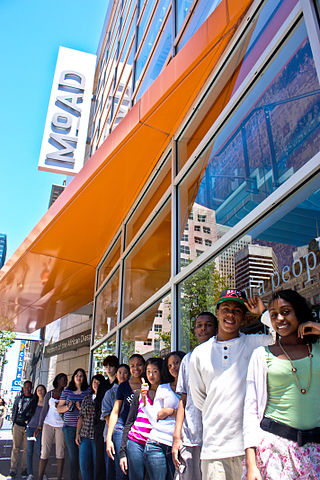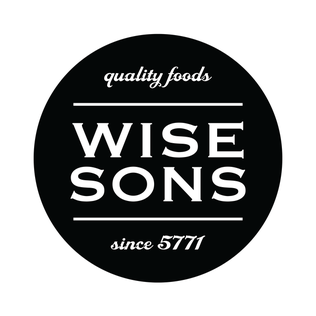
The San Francisco Museum of Modern Art (SFMOMA) is a modern and contemporary art museum and nonprofit organization located in San Francisco, California. SFMOMA was the first museum on the West Coast devoted solely to 20th-century art, and has built an internationally recognized collection with over 33,000 works of painting, sculpture, photography, architecture, design, and media arts. The collection is displayed in 170,000 square feet (16,000 m2) of exhibition space, making the museum one of the largest in the United States overall, and one of the largest in the world for modern and contemporary art. In 2024, SFMOMA was ranked 14th in the Washington Post's list of the best art museums in the U.S.

Daniel Libeskind is a Polish–American architect, artist, professor and set designer. Libeskind founded Studio Daniel Libeskind in 1989 with his wife, Nina, and is its principal design architect.

The Jewish Museum Berlin was opened in 2001 and is the largest Jewish museum in Europe. On 3,500 square metres of floor space, the museum presents the history of the Jews in Germany from the Middle Ages to the present day, with new focuses and new scenography. It consists of three buildings, two of which are new additions specifically built for the museum by architect Daniel Libeskind. German-Jewish history is documented in the collections, the library and the archive, and is reflected in the museum's program of events.

The Denver Art Museum (DAM) is an art museum located in the Civic Center of Denver, Colorado. With an encyclopedic collection of more than 70,000 diverse works from across the centuries and world, the DAM is one of the largest art museums between the West Coast and Chicago. It is known for its collection of American Indian art, as well as The Petrie Institute of Western American Art, which oversees the museum's Western art collection. The museum's Martin Building was designed by famed Italian architect Gio Ponti in 1971.

The Magnes Collection of Jewish Art and Life is an extensive collection of Jewish history, art, and culture at the University of California, Berkeley. The Magnes Collection comprises more than 30,000 Jewish artifacts and manuscripts, the third largest collection of its kind in the United States. The holdings of The Magnes Collection are catalogued into three distinct areas, which together constitute the single collection: the Archives, the Library, and the Museum.

The Museum of the African Diaspora (MoAD) is a contemporary art museum in San Francisco, California. MoAD holds exhibitions and presents artists exclusively of the African diaspora, one of only a few museums of its kind in the United States. Located at 685 Mission St. and occupying the first three floors of the St. Regis Museum Tower in the Yerba Buena Arts District, MoAD is a nonprofit organization as well as a Smithsonian Affiliate. Prior to 2014, MoAD educated visitors on the history, culture, and art of the African diaspora through permanent and rotating exhibitions. After a six-month refurbishment in 2014 to expand the gallery spaces, the museum reopened and transitioned into presenting exclusively fine arts exhibitions. MoAD does not have a permanent collection and instead works directly with artists or independent curators when developing exhibitions.
Renny Pritikin is an American curator, museum professional, writer, poet, and educator. He was the chief curator of San Francisco's Contemporary Jewish Museum from 2014 to 2018. He was Director of the Richard L. Nelson Gallery and the Fine Arts Collection at the University of California, Davis from 2004 to 2012.

Jewish ceremonial art is objects used by Jews for ritual purposes. Because enhancing a mitzvah by performing it with an especially beautiful object is considered a praiseworthy way of honoring God's commandments, Judaism has a long tradition of commissioning ritual objects from craftsmen and artists.
Alexander Gurevich is an Israeli painter and graphic artist. He was born in Alapaevsk, Ural where his family stayed during World War II. Gurevich's parents divorced when he was young; he and his mother returned to her hometown Leningrad when he was 18 months old. He was raised by his grandparents from mother's side. After finishing high school, he attended the then Leningrad Electrotechnical Institute (LETI) during 1961-1967, majoring in electronic engineering. Upon graduation Gurevich worked as an engineer for 5 years. In 1971 Gurevich enlisted into High Art College, named Muhina, from which he graduated 3.5 years later; after earning a degree in Industrial Design. He worked as a decorator for 15 following years, at the same time pursuing his unofficial creative career as an artist.

Bernard Baruch Zakheim was a Warsaw-born San Francisco muralist, best known for his work on the Coit Tower murals.
Sanford Ned Diller was an American billionaire and the founder of Prometheus Real Estate Group.
Lindsey White (1980) is a visual artist working across many disciplines including photography, video, sculpture, and book making. Her work has been described as "reveling in lighthearted gags and simple gestures to create an experience that is all the more satisfying for the puzzles it contains."
Susan Duhan Felix was an American ceramic artist who lived in Berkeley, California. Felix is well known for creating ceramics using the technique of pit firing. Her art is heavily influenced by spiritual traditions, especially Judaism. J-Weekly reported that Felix “has works in the collections of some highly regarded Jewish institutions: the National Museum of American Jewish History in Philadelphia, the Skirball Cultural Center in Los Angeles, and the Jewish Museum and Tolerance Center in Moscow.”
Davina Semo is an American artist working in sculpture. She completed her MFA at the University of California, San Diego in 2006 and a BA in Visual Arts from Brown University in 2003.
Jacques Schnier (1898–1988) was a Romanian-born American artist, sculptor, author, educator, and engineer. He was a sculpture professor at the University of California, Berkeley from 1936 to 1966.
Heidi Zuckerman is an American museum director and curator who is CEO and director of the Orange County Museum of Art in Costa Mesa, California.

Wise Sons Jewish Delicatessen is a small San Francisco-based chain of Jewish delis and bagel shops with 5 locations throughout the San Francisco Bay. It had previously expanded to Southern California and Tokyo, but those have since closed.

Alla Efimova is an art historian, curator, and consultant based in Berkeley, CA. She grew up in St. Petersburg, Russia.
Connie Zheng is a Chinese-born artist, writer, and filmmaker based in Oakland, California. Her projects include large-scale maps, seed exchanges, seed-making workshops, and experimental films about seeds. Themes in Zheng's work include navigating diasporic memory, ecological transformation, and relationships between human and more-than-human worlds.
Institute of Contemporary Art San Francisco is an American contemporary art museum that opened in October 2022, and was initially located in the Dogpatch neighborhood of San Francisco, California. By October 2024, it moved to the Financial District of San Francisco. Admission is free.























